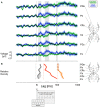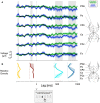Event-Related Potentials during a Gambling Task in Young Adults with Attention-Deficit/Hyperactivity Disorder
- PMID: 29535621
- PMCID: PMC5835343
- DOI: 10.3389/fnhum.2018.00079
Event-Related Potentials during a Gambling Task in Young Adults with Attention-Deficit/Hyperactivity Disorder
Abstract
Attention-deficit hyperactivity disorder (ADHD) is characterized by deficits in executive functions and decision making during childhood and adolescence. Contradictory results exist whether altered event-related potentials (ERPs) in adults are associated with the tendency of ADHD patients toward risky behavior. Clinically diagnosed ADHD patients (n = 18) and healthy controls (n = 18), aged between 18 and 29 (median 22 Yo), were screened with the Conners' Adult ADHD Rating Scales and assessed by the Mini-International Neuropsychiatric Interview, adult ADHD Self-Report Scale, and by the 60-item HEXACO Personality Inventory. The characteristic personality traits of ADHD patients were the high level of impulsiveness associated with lower values of agreeableness. All participants performed a probability gambling task (PGT) with two frequencies of the feedback information of the outcome. For each trial, ERPs were triggered by the self-paced trial onset and by the gamble selection. After trial onset, N2-P3a ERP component associated with the attentional load peaked earlier in the ADHD group than in controls. An N500 component related to the feedback frequency condition after trial onset and an N400-like component after gamble selection suggest a large affective stake of the decision making and an emphasized post-decisional evaluation of the choice made by the ADHD participants. By combining ERPs, related to the emotions associated with the feedback frequency condition, and behavioral analyses during completion of PGT, this study provides new findings on the neural dynamics that differentiate controls and young ADHD adults. In the patients' group, we raise the hypothesis that the activity of frontocentral and centroparietal neural circuits drive the decision-making processes dictated by an impaired cognitive workload followed by the build-up of large emotional feelings generated by the conflict toward the outcome of the gambling choice. Our results can be used for new investigations aimed at studying the fine spatiotemporal distribution of cortical activity, and the neural circuits that underly the generation of that activity, associated with the behavioral deficits characteristic of ADHD.
Keywords: ADHD; N2-P3; N400-like; decision-making; evoked potentials; personality.
Figures






Similar articles
-
Early Attentional Modulation by Working Memory Training in Young Adult ADHD Patients during a Risky Decision-Making Task.Brain Sci. 2020 Jan 9;10(1):38. doi: 10.3390/brainsci10010038. Brain Sci. 2020. PMID: 31936483 Free PMC article.
-
The neural basis of decision-making and reward processing in adults with euthymic bipolar disorder or attention-deficit/hyperactivity disorder (ADHD).PLoS One. 2012;7(5):e37306. doi: 10.1371/journal.pone.0037306. Epub 2012 May 18. PLoS One. 2012. PMID: 22624011 Free PMC article.
-
Mismatch negativity and P3a in drug-naive adults with attention-deficit hyperactivity disorder.Psychol Med. 2021 Mar 12;52(15):1-11. doi: 10.1017/S0033291720005516. Online ahead of print. Psychol Med. 2021. PMID: 33706818 Free PMC article.
-
Gambling behaviors and psychopathology related to Attention-Deficit/Hyperactivity Disorder (ADHD) in problem and non-problem adult gamblers.Psychiatry Res. 2016 May 30;239:232-8. doi: 10.1016/j.psychres.2016.03.028. Epub 2016 Mar 14. Psychiatry Res. 2016. PMID: 27031593
-
Immediate-release methylphenidate for attention deficit hyperactivity disorder (ADHD) in adults.Cochrane Database Syst Rev. 2021 Jan 18;1(1):CD013011. doi: 10.1002/14651858.CD013011.pub2. Cochrane Database Syst Rev. 2021. PMID: 33460048 Free PMC article.
Cited by
-
Disentangling ADHD's Presentation-Related Decision-Making-A Meta-Analytic Approach on Predominant Presentations.Front Psychiatry. 2021 Feb 18;12:519840. doi: 10.3389/fpsyt.2021.519840. eCollection 2021. Front Psychiatry. 2021. PMID: 33679462 Free PMC article.
-
Adult ADHD and emerging models of maladaptive personality: a meta-analytic review.BMC Psychiatry. 2021 Jun 1;21(1):282. doi: 10.1186/s12888-021-03284-1. BMC Psychiatry. 2021. PMID: 34074265 Free PMC article.
-
Early Attentional Modulation by Working Memory Training in Young Adult ADHD Patients during a Risky Decision-Making Task.Brain Sci. 2020 Jan 9;10(1):38. doi: 10.3390/brainsci10010038. Brain Sci. 2020. PMID: 31936483 Free PMC article.
-
Attention Networks in ADHD Adults after Working Memory Training with a Dual n-Back Task.Brain Sci. 2020 Oct 8;10(10):715. doi: 10.3390/brainsci10100715. Brain Sci. 2020. PMID: 33050115 Free PMC article.
References
-
- Albrecht B., Brandeis D., Uebel H., Heinrich H., Mueller U. C., Hasselhorn M., et al. (2008). Action monitoring in boys with attention-deficit/hyperactivity disorder, their non-affected siblings, and normal control subjects: evidence for an endophenotype. Biol. Psychiatry 64, 615–625. 10.1016/j.biopsych.2007.12.016 - DOI - PMC - PubMed
-
- American Psychiatric Association (2000). Diagnostic and Statistical Manual of Mental Disorders. 4th Edn Washington, DC: American Psychiatric Association.
LinkOut - more resources
Full Text Sources
Other Literature Sources

